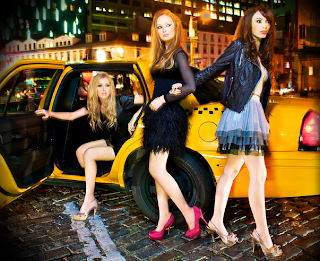 All three have on accessories like a pair of heels, or a jacket, or a bracelet. The
All three have on accessories like a pair of heels, or a jacket, or a bracelet. The
 All three have on accessories like a pair of heels, or a jacket, or a bracelet. The
All three have on accessories like a pair of heels, or a jacket, or a bracelet. The
The Betrayal of Christ
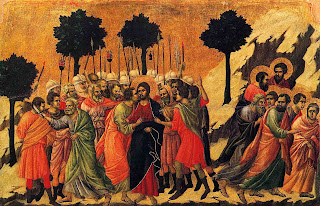
Duccio di Buoningsegna's The Betrayal of Christ depicts the capture of Jesus very clearly. There is no question as to what this particular painting is about. Judas is giving Jesus a kiss on the cheek to signify the guards which one he is and the disciples are running away. Christ is very easily spotted in the picture. Besides the kiss of Judas, Christ is in the center, he has a halo, and his robes are a blackish-blue color that completely contrasts the colors of His captors.
The Fifer
For my entire life (or at least as far back as I can remember) I have looked at this little boy. He has been sitting on a chair in our living room for the past seventeen years. He never ages, he never moves, or plays that flute of his. He just sits on our sofa—a boy in needlepoint. This pillow has always fascinated me. When I was little I would look at it and wonder about it. At one point I even took it down to my room to sit with the rest of my dolls.
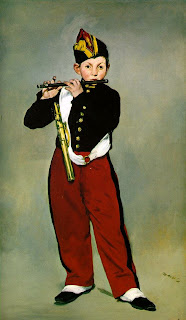
A couple months ago the Frist Center in Nashville announced that they were going to have an Impressionist exhibit of paintings from the Musee D’Orsay. The posters and signs had The Fifer on them but I was so surprised when I saw the Fifer’s rosy cheeks up on a billboard on the way downtown. I passed that billboard every day just waiting until the chance came that I could go see the exhibit.
I have always had a love for impressionist art—my favorites being Boudin’s seas and Degas’ ballerinas. I was able to see both of these at the Frist as well which was so exciting, but The Fifer was nothing that I could imagine. It was much larger in person. The Frist Center was something I was looking forward to for a while, but now that I’ve gone, I just want to go again……..

To his right the apostles stand facing away from Christ except for Peter who faces Christ and takes the righteous to heaven. Above the apostles, an enthroned Virgin Mary extends her hands in blessing while an angel trumpets to waken the dead. On the far left, the blessed ascend to heaven by holding on to the legs and wings of the angels. St. Peter oversees the operation with a key, and takes one righteous soul by the hand.
Below, more of the redeemed rise from their graves with the help of angels and rejoice. Towards the left, a person sits on his grave and unwraps his grave clothes, looking up in wonder. Among the saved can be spotted two bishops and two pilgrims. The pilgrims have symbols on their bags - a Greek cross for the pilgrimage to Jerusalem and a scallop shell representing Santiago de Compostela.
On Christ's right there is depicted the Weighing of Souls, presided over by Archangel Michael who leans on the scales to help them go in the right direction. Meanwhile, a devil attempts to sway the scales in his favor by hanging on them.
Along the bottom is an inscription warning against the horrors of Hell. On the far right, divided from the horrific scene by a vine, an angel trumpets to awaken the dead. Below this, more of the damned march to their doom. The most interesting are towards the right: a greedy man clutches his moneybags, and one sinner is pulled into Hell by two giant claws around his head. Two people sit on their tombs in their grave clothes. Compared with the joyful parallel on the left, they do not look to be in any hurry to cast them aside and stand up.

These very ornate looking things are called fibulas. The fibula served two purposes - as jewelry and as a clothes fastener (much like a safety pin or a button). The fibula was made in many different shapes and sizes. They would come with many different jewels and designs. The clothing worn by men and women during that era was not sewn. Fibulas were a common find. They were a necessity. The Etruscans were the first to wear fibulas. Often times the designs were zoomorphic. They had many animal figures. Very intricate metalwork was needed to make these fibulas.
They used fibulas to fasten their clothing to themselves, but they were also used as a means of status. That fancier fibula you had, the more important were. This Fibula was found in the Queen's burial in France. It shows two hooked fish and if you look closely you can see an eagle.
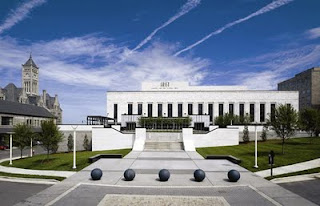
The Frist Center for the Visual Arts is an art museum in downtown Nashville. It has just recently finished exhibitions of Chilhuly and Haute Couture fashion. The vision of the Frist Center is to inspirepeople through art to lookat their world in new ways. The Frist strives to present and originate high quality exhibitions for the community. The center opened in April 2001, and since that time has hosted a spectacular array of art from the region, the country, and around the world.
Just recently at the Frist Center “The Golden Age of Couture” ended. This exhibition transports visitors to the most glamorous fashion houses of Paris and London in the years after WWII celebrating an important decade in fashion history that began with the launch of Christian Dior’s famous New Look in 1947 and ended with his death in 1957. The Frist Center is the only U.S. venue hosting this stunning exhibition from the Victoria and Albert Museum in London
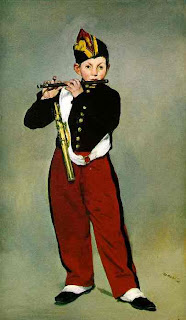
Coming up at the Frist Center an exhibition called “The Birth of Impressionism—Masterpieces from the Musée D’Orsay. The exhibition includes 100 masterpieces of mid-to-late 19th-centuryFrench painting from the Musée d’Orsay. This museum in Paris is dedicated to the art of the early modern period (1840s through the early 20th century). The exhibition includes artists such as Courbet, Manet, Cézanne, Monet, and Renoir, Degas, Fantin-Latour, and Whistler. I’m looking forward to this event mainly for the six works by Degas, including Ballet Rehearsal on the Set.
The Frist Center is a beautiful museum filled with magnificent art. If you live in Nashville or are simply visiting, you must see the Frist. For more information click here.
January 2, 2007
A young woman is on her way to pick up her daughter in an old black comet convertible. She has the top down with the music blaring. She thinks she is the only one on the road. She is late and decides to run the red light in front of her instead of coming to a stop. Little does she know that another car is speeding through the light. She is hit. The scene is a street now silent after the deafening noise. Nothing else is clear except the fact that she has made the wrong choice. Nothing else is clear except for the red light.
The sketch is an abstract drawing titled January 2, 2007. Clare Coyle Taylor’s drawing from colored pencils on bristol board has many different primary colors. Coyle layers many of the colors giving it a slightly murky color. It is somewhat unclear as to what the rest of the picture is. The focal point is the red circle that is slightly off center. It is the clearest part of the whole sketch. The pencil marks are long and random without any organization or pattern. She does not try very hard to stay within the border that she has drawn. She uses black for the outsides of the two larger squares in the middle. This sketch shows the clarity of the red light and the unclearness of the rest of the sketch.

Claude Monet
The most distinctive feature of the work is the perfect use of color. Monet used earth tomes like green and brown to create this painting. Monet used different shades of yellows and greens to show the differences in the trees. Violet is used in the foreground water along with blues. The blues of the sky and the blues of the water are similar showing the reflection of the sky in the water White is used as an accent throughout the piece.
Monet uses colors that are side by side on the color wheel. Red, violet, blue-violet, blue, blue-green, yellow-green and yellow are the main colors. The colors are put side by side instead of blended together. This makes it look more realistic. There are lots of cool colors to make the painting look more relaxed and exciting.
Based on natural lighting, the darkest values are the shaded areas. There is. The boats and the restaurant are dark and in a shadow at the front of the painting. The sky is light and bright on the left and dark and cloudy on the right. The natural sunlight shades different areas of the piece. For example, shading of the foreground in and around the island, when the background is lighted by the natural light, and is not shaded.
There are many lines and angles evident in this painting. Horizontal lines are seen where the shoreline is in the background as well as where the bridge connects the floating platform and the café. There is a horizontal line where the shore line should be in the foreground. Vertical lines are the trees across the shore in the background; branches hanging in the foreground, and some of the people are vertical, but not all of them.
The rooflines are made to make the roof appear to slant at an angle. There are some geometric lines and shapes on the boats and café. The floating platform is large and round. It draws everything to it for the focal point of the piece.
Monet uses the dock and the railing to create lines going towards the raft. The boats create a line pointing directly at the floating platform at the center of the painting. The lines all draw attention to the center.
Linear perspective is shown in many ways. The island looks as if it is a top of a cylinder. The corner of the restaurant is at an angle so it gives it depth. The bridge on the left side is also angled diagonally left to show that you can walk to the island. The boats are painted only to show the top and the side of them and they are also angled so you can view them from the side.
Every inch of space is covered with paint. There are no negative spaces. The painting is not perfectly symmetrical, yet it is balanced. The center island is not actually in the very center, but just off center. The painting is balanced well. There is something happening in each one of the sections. The corner of the restaurant shown on the right side takes up space and you can view the people in the restaurant. The dancing pavilion in the center pulls your eyes more towards center and they also have a better view of the people sitting and dancing. On the left side you can view people swimming, and also the boats give that side more of full balanced look.
The painting gives a lot of perspective. The island is distant from the two boats and that shows that there is distance between the island and the docked boats. Also the two bridges show perspective between the island and restaurant, and between the island and the land the bridge appears to be extending out to. In the background the beach appears to be far in the distance. The trees on the beach show scale between the two. The people who are swimming look as if they are distant from the island because of the water between them, their smaller size, and the clarity and detail.
Monet uses very short, swift brushstrokes. The small variations between the sizes of the strokes in foreground and background are done to suggest depth. His brushwork is very descriptive changing sizes for different forms. Long even strokes outline the boats, short horizontal smears indicate the foreground water and background trees, and abrupt jabs are used for the foreground trees.
These different aspects of the painting show a fair day at the lake. The strokes of the brush show movement in the water. Monet’s use of light, motion, nature, distinctive brush strokes and the white make the painting seem very realistic.
